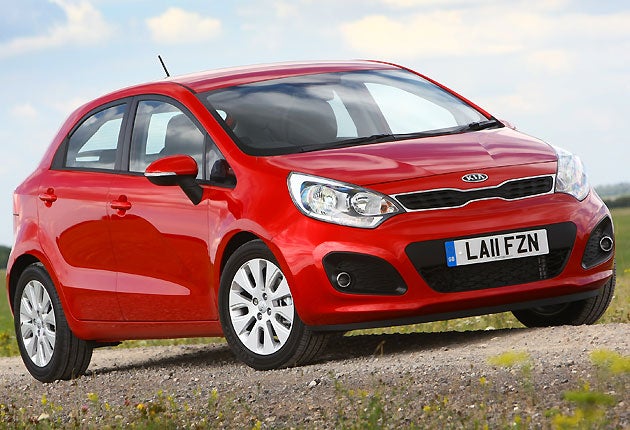Kia Rio 1.4 2
This Rio needs a touch more carnival spirit

I wrote recently about the "size creep" in small cars, to the extent that what the motor industry refers to as "superminis" are really no longer mini at all.
Cars of the Ford Fiesta and Volkswagen Polo class, including the new Toyota Yaris tested last week, have become big enough to function as viable, all-purpose family cars.
Kia's new Picanto is one of the best examples of today's "real" superminis. So where does that leave the same company's just-launched Rio? Stealing sales from the Ford Focus-sized Kia C'eed that sits on the next rung of the Kia ladder? Very possibly; but that car, too, is about to be replaced and it will, of course, be a bit bigger again.
So here is the new Rio, just over four metres long (13ft 3in in old money) and every inch the complete family car. This is a stockily handsome machine, with the high, rising waistline and centrally-pinched front upper grille of all new Kia designs.
Under the high, bulbous nose hides one of four possible engines. The smallest is a 1.1-litre, three-cylinder turbodiesel with 74bhp and, at 85g/km, the lowest official CO2 emissions of any conventionally-engined, four/five-seater car made anywhere in the world. There are also a 1.4-litre diesel (89bhp), a 1.25-litre petrol engine (83bhp) and the subject of this test, a 1.4-litre petrol unit with a healthy 107bhp. All except the 1.25 have a six-speed gearbox, with an automatic – containing just four forward gears – optional for the petrol 1.4.
After the neat boldness of the exterior, the interior is a disappointment. A high, deep dashboard looms ahead in an expanse of dark grey, but at least the main frontage of it is padded and the piano-key switches for the air conditioning are unusual. The three main dials include an enormous fuel gauge, while the small, central information display is hard to read in its orangey-red lettering. Hard, coarse-grained plastic covers most of the lower door area, but the detail finish and air of subjective quality does better those of last week's Yaris.
There's plenty of space, but the boot has a high sill and the small, high rear window, bounded by thick pillars, makes reverse-parking an act of some faith. Our test car is in trim level "2" out of three, but even the "1" is very well equipped. The top version has LED bulbs for the daytime running lights, more loudspeakers, a cruise control, heated seats, darkened "privacy" rear glass, automatic air-con and hefty 17in wheels.
This wheel size also appears, as an option, on the test car, which explains why it can fidget at low speeds on bumpy roads. As the pace rises, the Rio smooths out well. It feels taut and composed on a twisty road, with electric power steering free of the rubbery, glutinous feeling that plagues some such systems even if the weighting, though well judged, is entirely artificial and never changes regardless of the forces acting on the front wheels. Most drivers will no doubt think it fine until they come to drive the Rio on snow and ice.
Anaesthesia creeps into the clutch's lightweight action, too, making it hard to feel exactly where the biting point is. Against that, the brakes are firm and progressive and the gearchange is precise. The 1.4-litre petrol engine is almost inaudible at idle and quiet at other times, but despite its claimed 107bhp it feels feeble at low engine speeds and is easily defeated by hills.
This Rio is almost an excellent car. It needs the reversing camera offered in some rivals, and it needs more enthusiasm from its engine. A brighter interior design would help, too, especially in a car named after one of the world's more vibrant cities.
Otherwise the Rio is impressive for its quality, its solidity, its refinement, and for the way it looks. It is also excellent value – the range costs from £10,595 to £14,895 – and comes with a longer warranty than any rival at seven years or 100,000 miles. For many buyers that will be enough. The fact that the Rio is properly competitive with the best that Europe and Japan have to offer is a welcome bonus.
The Rivals
Ford Fiesta 1.4 Zetec: £13,395, 96bhp, 133g/km
Highly stylish, comfortable, the most fun to drive in its class, quality interior, deservedly popular. Less power than Rio but feels more.
Toyota Yaris 1.33 TR: £13,260, 98bhp, 123g/km
Third-generation Yaris loses charm and innovative instruments, gains wedgy look and impressive multimedia. Cheap cabin, unexciting.
Volkswagen Polo 1.4 Match: £13,225, 85bhp, 139g/km
Good value and the most natural-feeling steering in this class because the assistance isn't electric. Dour cabin, though.
Join our commenting forum
Join thought-provoking conversations, follow other Independent readers and see their replies
Comments